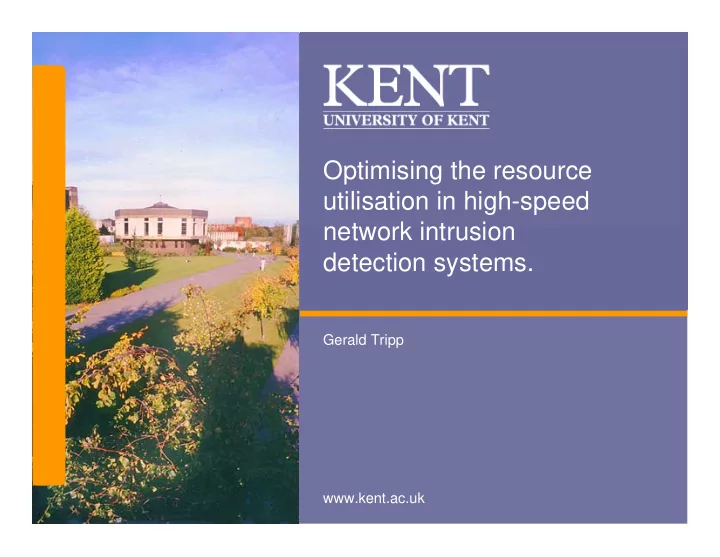

Optimising the resource utilisation in high-speed network intrusion detection systems. Gerald Tripp www.kent.ac.uk
Network intrusion detection • Network intrusion detection systems are provided to detect the presence of various security attacks. • This could be a virus or an attack that takes advantage of some form of weakness in the system. • Typically operates by searching for various patterns or strings within each network packet. • Difficult for software to keep up with traffic rate for high speed networks. • Can build custom hardware for this within a Field Programmable Gate Array (FPGA) • Implement string matching using an 'automata' based design 2
FPGA based implementation • One common method is to implement an automata as a series of comparator, flip flops and gates. • Good resource utilisation • But: need to rebuild the design if we change the search strings • Can use a table based automata implementation. • Dynamically update-able at run time. • Use internal memory to avoid pipeline delays to external RAM • But: limited numbers of Block RAM primitives within FPGAs. 3
Using Logic ... • We can instead use logic cells (LUTs – Look Up Tables) as small blocks of memory. • But: they are rather small (16-bits each in Xilinx FPGAs) • However, there are plenty of them ... • The basic single LUT memory is also single port … • We can however use these as shift registers ... • SR16 primitive – implemented as a single LUT. • Use the shift data operation to load them with information • Use a selective shift out port to read out particular bits 4
Standard shift register: SR16 Shift Shift in D Q15 out and enable CE clock A Q • The 'programmable length' facility enables Q to output the shift register bit selected by A 5
Generic Memory Block of size: 2 N x W bits • Instantiate number of shift registers as required. • Link shift registers together inside the memory block • Serial load data and enable, in and out • Daisy chain to link memory blocks together for loading. Address Data out A D N W SDI SDO Serial Serial SEI SEO load out load in Clock 6
Basic string matching engine. Generic design: Match Data in vector state compress automata out 8 A S decoder N • A – bus width of compressed input • S – number of bits in state variable • N – number of different match strings 7
Basic Matching 'engine'. • Use a compacted table for the automata based on “row displacement with state marking” • This is a traditional parser technique. • New variable P: address bus width into main automata table • Use a similar technique for the compression system. • Variable CL: address bus width into main compression table • Build state decoder as two stages: • First: compress current state into a value (width K bits) indicating one of the terminal states or that its a non-terminal. • Secondly: decode this into a match vector. 8
Determining resource utilisation • Now have a completely parametrised design ... • Build a rough (mathematical) model of resource utilisation for an 'matching engine' dependent on these parameters. • For each valid set of parameters: • Process a set of Intrusion Detection rules to see how many 'engines' are needed • Determine the approximate per search byte resource utilisation. • Pick the most likely candidates and plot a graph • Pick an optimal candidate and build an FPGA design for it ... 9
Search engine resource utilisation Parameter key: 5.0 CL,A,S,P 4.8 C:6,6,6,6 LUTs/search byte 4.6 C:6,6,7,7 C:7,6,7,7 4.4 C:7,7,7,7 4.2 C:7,7,8,8 C:8,6,7,7 4.0 C:8,7,8,8 3.8 3.6 0 5 10 15 20 25 30 ( ) ⎡ ⎤ = + Maximum strings per engine (N) K log 2 N 1
Results – Target device: Xilinx XC2VP7-7 Parameters: CL=7, A=6, S=7, P=7, K=4, N=15 • Max. of 15 search strings / engine (average of about 10 to 11) • Resources for each engine: • LUTs: 410 out of 9856 (4% of XC2VP7) • Can probably fit about 215 engines into a larger XC2VP100 • i.e. Search for around 2200 strings in parallel • Search rate: 1.2 Gbps • Independent of search strings or input data. • Tested by simulation as a VHDL model … 11
Conclusions & Further work • Flexible VHDL model for a string matching system • Using just FPGA LUTs. • Dynamically update-able at run time. • Only byte at a time string matching so far • Can look at incorporating in existing work with multi-byte input matching systems and regular expression matching. • This design uses just LUT primitives ... • Can look at how this might be used in conjunction with the larger BRAM primitives for more optimal implementations. 12
Recommend
More recommend